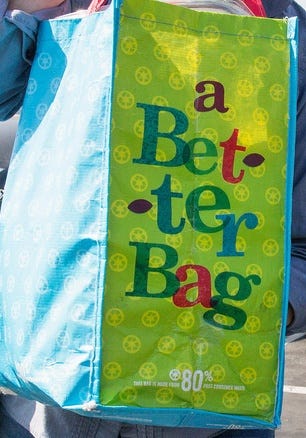The Great Californian Bag Surplus
I just got back from a long vacation in my home state of California. The bad news about California is that its people and government have unusually severe economic illiteracy. The good news is that their severe economic illiteracy provides enough illuminating examples to fill a textbook. This trip, my favorite case in point has been California’s law requiring stores to charge at least ten cents per bag.
Economically speaking, what is this law? Most non-economists call it a “tax on bags,” but it’s totally not. A seller is legally allowed to absorb a tax if he is so inclined. If the government imposes a $1 tax on a $10 product, for example, a seller is legally free to cut the list price to $9 so the price with tax stays at $10. But California merchants are not allowed to charge customers less than $.10 a bag.
If the law isn’t a tax, what is it? A price control. What kind of price control? A minimum price, also known as a price floor. And since bags used to be free, this is clearly a binding floor.
The primary effect of a binding price floor is to create a surplus. At a price of $.10 per bag, sellers want to sell a lot more bags than customers want to buy. This may sound strange to California residents: “It’s really hard to get bags now. What do you means there’s a ‘surplus’?” But that only shows they don’t understand the textbook concept. A surplus doesn’t mean abundance; it means abundance from the seller’s point-of-view, combined with scarcity from the buyer’s point-of-view. In fact, textbook econ implies that the bigger the surplus, the less human beings consume.
But binding price floors also have a secondary effect: they raise quality. If merchants can’t make their bags more attractive to consumers by cutting their price, the next-best strategy is to make their bags better. This abstruse textbook prediction was uniformly fulfilled in every grocery store I saw in California. Indeed, I’ve never had better bags in my life! Every bag was sturdy, pristine, and decorated. This bag says it all:

But aren’t high-quality bags a good thing? The general answer is: not necessarily. Quality costs more; markets let people decide for themselves whether the extra quality is worth the extra cost. When price floors spur higher quality, however, the extra quality is normally not worth the extra cost. How do we know? Because before the law was passed, sellers were free to offer higher-quality, higher-cost bags, but rarely did, demonstrating that consumers place little value on extra quality.
Defenders of California’s law who know a smattering of economics will no doubt appeal to the negative externalities of plastic bags. But in this case, a little knowledge is a dangerous thing. If you’re doing practical policy analysis, you can’t just point to a negative externality. You’ve got to do quantitative cost-benefit analysis: How much cleaner will the $.10 bag law make the planet – and much aggravation will it inflict on consumers? I can’t find any decent numbers on Google or Google Scholar, but it’s pretty obvious that bags are a tiny fraction of all plastic, and plastic a tiny fraction of all potentially hazardous trash. And it’s even more obvious that bringing your own bags to shop is a pain in the neck.
Even if environmental costs heavily outweigh convenience benefits, however, price floors are almost always inferior to simple taxes. See any decent intro econ textbook: When firms can’t efficiently compete on price, they inefficiently compete on everything else. Taxes change behavior, too, but only by changing prices – leaving firms and consumers free to flexibly and creatively adapt. And instead of burning up resources on inconvenience and overly fancy bags, taxes change behavior and raise government revenue at the same time.
Strangely, then, the only people with a halfway-decent reason to prefer California’s policy to a simple bag tax are libertarians who take the Starve the Beast strategy to its radical conclusion. Everyone else in California desperately needs to read an econ textbook before he votes again.
The post appeared first on Econlib.


